The Google Pixel C Review
by Brandon Chester & Joshua Ho on January 25, 2016 8:00 AM ESTDisplay Analysis
At the launch event for their new Nexus phones and the Pixel C, Google made a point of advertising the Pixel C’s display as a 2560x1800 panel with a 500nit brightness, a 1.422 aspect ratio, and a low-temperature polycrystalline silicon (LTPS) backplane. The use of LTPS doesn’t have a direct impact on the user as far as display accuracy is concerned, but it can help to lower power usage and increase brightness by reducing the size of light-blocking circuitry. This can also lead to longer battery life by reducing display power, as the backlights don’t need to be pushed to as high of a brightness.
The Pixel C’s aspect ratio is a very interesting choice. While one can consider the 4:3 aspect ratio of the iPad to be fairly close to a digitized sheet of 11 x 8.5” paper, the fact that most of the world uses A series paper which has a square root of two 2 aspect ratio makes the Pixel C especially well-suited for displaying those documents. It’s a wider aspect ratio than what you get with a 4:3 display, but not as wide as the one on a 16:10 Android tablet, and slightly less wide than Microsoft’s Surface Tablets which have a 3:2 aspect ratio. However, the Pixel C is still wide enough that you’re clearly intended to use it in a landscape orientation. Landscape doesn’t lend itself well to the majority of Android apps that just throw up a big phone UI and call it a day, and I feel that it may have been a mistake on Google’s part. A future update to enable split-screen multitasking may change things here, but for now you’re stuck with an interface and applications that just don’t feel at home on a display of these proportions.
Something that I felt worth noting about the Pixel C was how reflective the glass appears to be. While we don’t have a test for the exact reflectivity of a display, it’s something that can be fairly well gauged just by using the device and making comparative observations to other devices. All of the Android tablets I review are clearly more reflective than the latest iPads due to the lack of anti-reflective coatings, but the Pixel C really stands out for its high reflectance. I’ve had a number of issues using the Pixel C due to reflections making it impossible to see what’s on the screen, which means that I have to increase the brightness to compensate. This subsequently reduces the battery life because it increases the power consumed by the display. While Google is able to overcome these issues due to their high brightness, utilizing an anti-reflective coating to allow for visibility even with a low brightness allows for better real-world battery life.
In addition to fairly basic specifications like brightness, resolution, and aspect ratio, a display has many other aspects relating to color accuracy. On mobile platforms, a display must target the sRGB color standard to accurately render the content that one will find on the web, and through all video streaming and photo sharing services. To evaluate a display’s accuracy relative to the sRGB standard we run it through our custom display workflow, using an X-Rite i1Pro 2 spectrophotometer and i1Display Pro colorimeter along with SpectraCal’s CalMAN 5 software for collecting and managing the data.

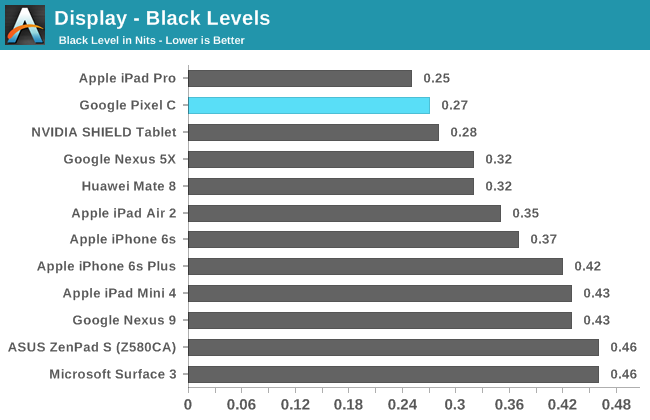
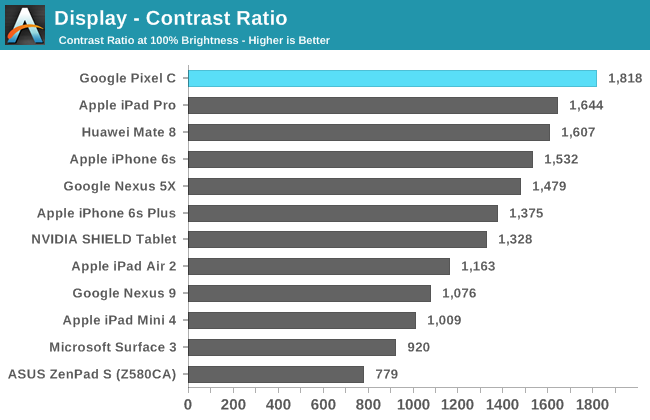
The Pixel C’s display goes up to 495 nits measured at the center of the display, and so Google was quite accurate in their advertisement of 500nits. This is the brightest tablet on record, beating the Nexus 9 by around 25 nits. As I mentioned earlier, the highly reflective glass makes the high brightness levels quite necessary, which will likely end up impacting the real-world battery life that Pixel C owners see. It’s also worth noting that the touch sensor layer is highly visible when light shines on the display, which makes it even more difficult to use outdoors or with overhead lighting. This is something that I’ve only seen managed well on Samsung and Apple devices, and for a flagship Android tablet with a completely custom display I expect better in this regard than what the Pixel C delivers.
In addition to the high brightness, the Pixel C has quite deep black levels for an LCD tablet. With a black level of 0.2718 nits and a contrast ratio of 1818 at max brightness, the Pixel C has the best contrast of any tablet that we’ve seen to date, besting even the iPad Pro.
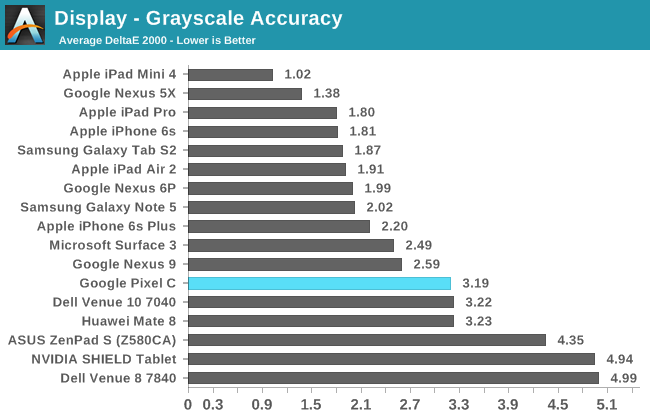
Greyscale accuracy on the Pixel C is fairly good, with a DeltaE error value slightly over the motion-visible value of 3. The error is mostly due to the green component of luminance dropping as you move from black to white. While we certainly have been spoiled by the rapid increase in mobile display quality over the last few years, I do think that Google could have pushed color accuracy higher here. That isn’t to say that I think the Pixel C will disappoint, but considering that it’s an entirely custom panel on a premium device that won’t be shipping in high volume, I think Google could have gone a bit further. Competition is getting fairly fierce in this category, with devices pushing for DeltaE values below 2, and some units achieving values below 1 which would make the error impossible for the eye to detect in any circumstance. In the end, the Pixel C’s greyscale accuracy is quite good, but it’s not the absolute best that I’ve seen.

The Pixel C’s accuracy with rendering primary and secondary color saturations is excellent. With an average DeltaE value below 2, I doubt any person will find themselves bothered by what little inaccuracy there is. The only color that actually exhibits an error above 3 is 100% red, with the remaining values all sitting below.
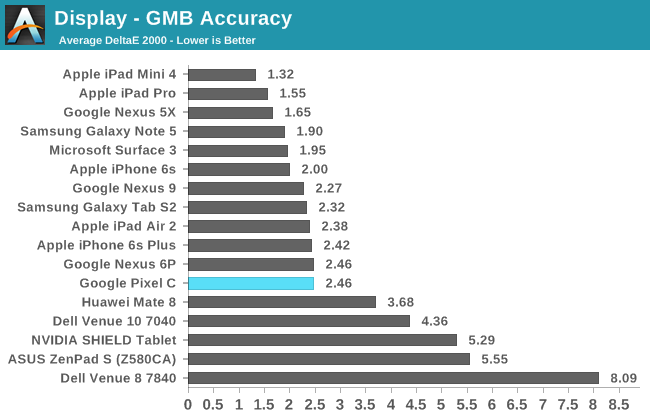
The Pixel C does quite well in the Gretag-MacBeth ColorChecker test. The average error is below 3, with the only outliers being color mixtures that primarily have a blue component, along with the greyscale values that are included in the test. Most other colors have DeltaE values somewhere between 1 and 2, and with that kind of accuracy I don’t really have any complaints, even if it’s not the absolute best result that I’ve ever seen.
In the end, the Pixel C comes with a bright, accurate, and high resolution display, with one of the highest contrast ratios that I’ve seen on a tablet. Google could definitely improve greyscale performance a little, and all companies need to start applying the same sort of anti-reflective coatings that Apple applies to their iPads, because the difference in outdoor usability is dramatic when you compare them. The Pixel C’s high reflectivity has been a noticeable obstacle when using it in environments that have overhead lighting, which includes my own home. That kind of little detail is the sort of thing that, when properly recognized and addressed, can really take a product to the next level. As it is, the Pixel C’s display is very good in many respects, but among high end tablets it’s not one I can call the absolute best.



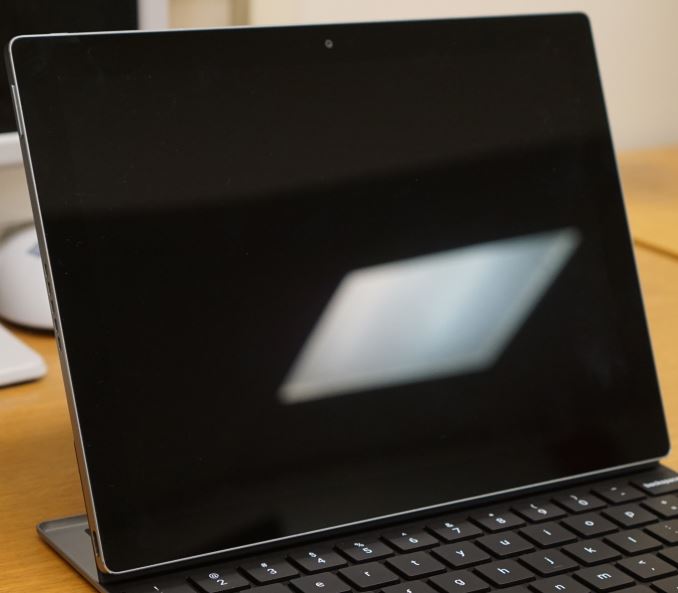
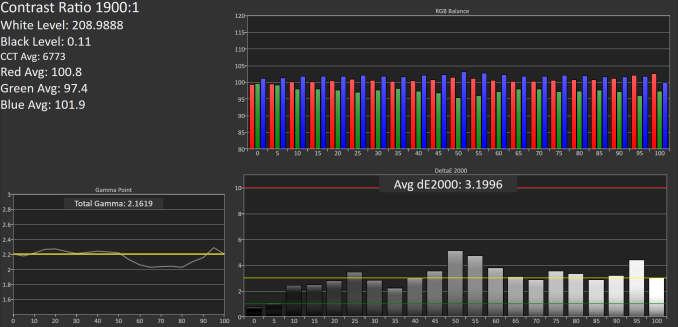

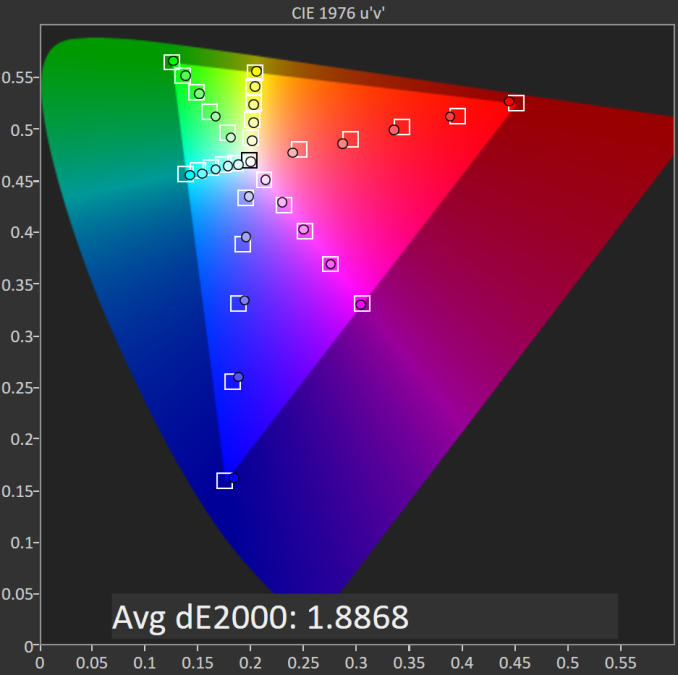









122 Comments
View All Comments
valentin-835 - Monday, January 25, 2016 - link
The tablet has issues. You kind of get what you pay for. I mean, it's half the price of an IPad Pro. And less than half that of a Surface.The biggest drawback however is the lack of an advanced graphics API like Metal or DX12. Without that, they are dead in the water. I heard Google is pushing hard to get Vulkan released. Both drivers and specification should be out soon.
styleruk - Monday, January 25, 2016 - link
Hmm, there seems to be an awful lot of points about a Google tablet or android tablet not being much more than a big phone. I have to disagree. I use the N9 for business and pleasure. I often type out reports on the N9 at airports, watch movies, read mags, books and play occasional games. I've had both android and apple phones both have good and bad points, currently on apple phone, but at work there are 2 iPad tablets I could use if I wanted, but they are simply too restricted to my needs. For me, the N5 + Google's more open approach is far more efficient. Up to now, I've had no problem with lack of multi task... to fill in my diary and read an email is simply to switch...its no biggie. If I want more I wait until I'm in front of a PC at work or home.I also like the way everything Google works together well.
Regarding this device, I'm on the cusp of upgrading my N9, but quite why I can't see yet. Until I actually pick it up and try it, I'm not ordering it, as the last upgrade was from the N7(2013), to N9, and whilst bigger, it's not really faster. On paper, the pixel C is not much faster than the N9!
The jury is still out...but stop saying that android tablets are just big phones, I have the choice and I don't agree at all.
tuxRoller - Monday, January 25, 2016 - link
Just looking at the benchmarks, your not judging this device fairly.The nexus 9 had a processor that was basically designed for benchmarking and nothing else. It just falls on its face when the code becomes branchy. Iow, benchmarks were an unusually poor indicator of typical performance.
That aside, the pixel is performs pretty much exactly where you'd expect it to perform given its CPU: between the nexus 5x and the 6p FOR MOST TESTS.
Iow, no surprises.
I'd also like to point out that the weight is only an issue if you have some physical issues, or are just used to very light tablets. I received the pixel c for Xmas and have had no issues transitioning to it from the 2013 nexus 7. My gf even noted when she first picked it up that "this isn't very heavy" (she'd read the reviews which complained about its weight).
I certainly have issues with it (it often doesn't respond to touches, sometimes the interface becomes so slow I have to force a restart) but it's still an awfully good TABLET for the price.
c4v3man - Monday, January 25, 2016 - link
I gave up on waiting for a return to sanely priced android tablets and went with a Dell Venue 11 Pro 7140. Like most non-apple products they don't hold their value particularly well, so I was able to score a Core 5M71 256GB SSD version with the keyboard for under $600. While heavier than initially anticipated, I get excellent battery life (13+ hours real world display use with the keyboard battery), and an extremely snappy tablet that even handles light Adobe Lightroom usage. That and it works on a lap, unlike a Surface, and is serviceable (good luck replacing the battery/ssd in your surface). Remix OS works on it as well if I need to get my android fix, and will likely get better with more development. I guess I don't see the point of using a more limited OS on a $500+ device... If you're going for productivity and charging a premium, give me a full experience. If it's a limited experience, it better come with a "limited" price.Jerch - Monday, January 25, 2016 - link
Always sad to see the Nexus 7 (2013) omitted from display lists, since even though it is now firmly outdated, it had a great screen that would still be at the top of some of these tests -- notably max brightness. It's the perfect beach tablet. Cheap, durable, and BRIGHT.EludiumQ36 - Monday, January 25, 2016 - link
I have a 32GB Pixel C and take it from a regular user as opposed to a professional reviewer/critic - it's a very good tablet. I use it as a true tablet sans keyboard which mitigates much of the complaining. It features a beautiful and very responsive display (utilizing Android 6.0.1). It was my perfect choice because (1) the Nexus 10 is no longer available, (2) it's far less expensive than the 10-in Samsung tablets (which are stuck on KitKat), and (3) it's basically a Nexus with first-in-line upgrades. Having said that, there is a highly reported problem of Wifi performance degradation - I experience a 60% hit but still get 26Mbps to it, so... - but they'll issue a fix for that soon enough. I highly recommend it if you count yourself as a "regular" user.R. Hunt - Tuesday, January 26, 2016 - link
Granted, Samsung is not great with updates. That out of the way, even last year's Tab S is been on Lollipop for months. And how is this less expensive than say, the Tab S2?Jumangi - Monday, January 25, 2016 - link
Google just doesn't care about making Android a good experience on larger tablets. Until,they do we will get half baked products like this and the iPad will continue to be the standard.McChen - Tuesday, January 26, 2016 - link
One thing that wasn't mentioned in the review is that the Pixel C supports faster charging (12V @ 2A, 24W) via USB PD using a charger such as the Pixel laptop charger. I have one and indeed the tablet charges very fast with it. I believe one of the Google engineers said it charges 0 to 100 in about 2.5 hours, compared to just over 4 hours in this review with the standard 15W charger. Would be interesting to see a charging time test with a USB PD charger.Jumangi - Tuesday, January 26, 2016 - link
They used the charger the device comes with as they should.